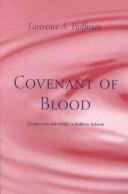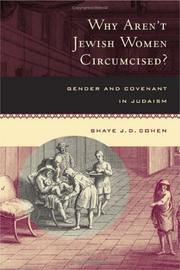| Listing 1 - 5 of 5 |
Sort by
|
Dissertation
ISBN: 9051667981 Year: 2000 Publisher: Delft Eburon
Abstract | Keywords | Export | Availability | Bookmark
 Loading...
Loading...Choose an application
- Reference Manager
- EndNote
- RefWorks (Direct export to RefWorks)
Berit milah --- 392.1 --- 296*516 --- Berit mila --- Berith --- Berith milah --- Bris --- Briss --- Brit periah --- Brith --- Periah --- Circumcision --- Judaism --- Doop. Besnijdenis. Initiatie. Meerjarigverklaring --- Joodse liturgische gebruiken en symbolen --- Religious aspects --- Customs and practices --- Theses --- Berit milah. --- 296*516 Joodse liturgische gebruiken en symbolen --- 392.1 Doop. Besnijdenis. Initiatie. Meerjarigverklaring

ISBN: 0226347834 0226347842 Year: 1996 Publisher: London University of Chicago Press
Abstract | Keywords | Export | Availability | Bookmark
 Loading...
Loading...Choose an application
- Reference Manager
- EndNote
- RefWorks (Direct export to RefWorks)
Central to both biblical narrative and rabbinic commentary, circumcision has remained a defining rite of Jewish identity, a symbol so powerful that challenges to it have always been considered taboo. Lawrence Hoffman seeks to find out why circumcision holds such an important place in the Jewish psyche. He traces the symbolism of circumcision through Jewish history, examining its evolution as a symbol of the covenant in the post-exilic period of the Bible and its subsequent meaning in the formative era of Mishnah and Talmud. In the rabbinic system, Hoffman argues, circumcision was neither a birth ritual nor the beginning of the human life cycle, but a rite of covenantal initiation into a male "life line". Although the evolution of the rite was shaped by rabbinic debates with early Christianity, the Rabbis shared with the church a view of blood as providing salvation. Hoffman examines the particular significance of circumcision blood, which, in addition to its salvific role, contrasted with menstrual blood to symbolize the gender dichotomy within the rabbinic system. His analysis of the Rabbis' views of circumcision and menstrual blood sheds light on the marginalization of women in rabbinic law. Differentiating official mores about gender from actual practice, Hoffman surveys women's spirituality within rabbinic society and examines the roles mothers played in their sons' circumcisions until the medieval period, when they were finally excluded.
Berit milah --- Blood --- Rabbinical literature --- Women in rabbinical literature. --- History. --- Religious aspects --- Judaism. --- History and criticism. --- Women in rabbinical literature --- Body fluids --- Fear of blood --- Berit mila --- Berith --- Berith milah --- Bris --- Briss --- Brit periah --- Brith --- Periah --- Circumcision --- Judaism --- Women in the Talmud --- History --- Religious aspects&delete& --- History and criticism --- Customs and practices
Book
ISBN: 9783161506284 3161506286 Year: 2010 Volume: 295 Publisher: Tübingen Mohr Siebeck
Abstract | Keywords | Export | Availability | Bookmark
 Loading...
Loading...Choose an application
- Reference Manager
- EndNote
- RefWorks (Direct export to RefWorks)
Bible --- Jewish religion --- Circumcision --- Berit milah --- Religious aspects --- Judaism --- Christianity --- History --- 392.1 --- Doop. Besnijdenis. Initiatie. Meerjarigverklaring --- 392.1 Doop. Besnijdenis. Initiatie. Meerjarigverklaring --- Amputation, Foreskin --- Foreskin amputation --- Foreskin removal --- Male circumcision --- Prepucectomy --- Removal of foreskin --- Body marking --- Foreskin --- Initiation rites --- Berit mila --- Berith --- Berith milah --- Bris --- Briss --- Brit periah --- Brith --- Periah --- Religious aspects&delete& --- Surgery --- Customs and practices --- Circumcision - Religious aspects - Judaism --- Circumcision - Religious aspects - Christianity --- Circumcision - History

ISBN: 1282356283 9786612356285 052092049X 1598755897 9780520920491 1423717279 9781423717270 9781598755893 9780520212503 0520212509 9780520244580 0520244583 9781282356283 6612356286 Year: 2005 Publisher: Berkeley University of California Press
Abstract | Keywords | Export | Availability | Bookmark
 Loading...
Loading...Choose an application
- Reference Manager
- EndNote
- RefWorks (Direct export to RefWorks)
Why aren't Jewish women circumcised? This improbable question, first advanced by anti-Jewish Christian polemicists, is the point of departure for this wide-ranging exploration of gender and Jewishness in Jewish thought. With a lively command of a wide range of Jewish sources-from the Bible and the Talmud to the legal and philosophical writings of the Middle Ages to Enlightenment thinkers and modern scholars-Shaye J. D. Cohen considers the varied responses to this provocative question and in the process provides the fullest cultural history of Jewish circumcision available.
Jews --- Rabbinical literature --- Women in rabbinical literature. --- Circumcision --- Berit milah --- Identity, Jewish --- Jewish identity --- Jewishness --- Jewish law --- Jewish nationalism --- Women in the Talmud --- Berit mila --- Berith --- Berith milah --- Bris --- Briss --- Brit periah --- Brith --- Periah --- Judaism --- Identity. --- History and criticism. --- Religious aspects --- Judaism. --- History. --- Ethnic identity --- Race identity --- Legal status, laws, etc. --- Customs and practices --- absence of circumcision. --- bekhor shor. --- benediction. --- benet. --- berakhot. --- bible. --- blessing. --- ceremony. --- circumcision. --- cultural history. --- doctrine. --- femininity. --- feminism. --- gender roles. --- gender studies. --- gender. --- jewish circumcision. --- jewish life. --- jewish women. --- jewish. --- judaica. --- judaism. --- nonfiction. --- orthodoxy. --- rabbinics. --- religion. --- religious belief. --- religious practices. --- religious women. --- rite. --- ritual. --- talmud. --- theology. --- torah. --- tradition. --- women and religion.
Book
ISBN: 9781589834095 1589834097 9781589834101 1589834100 Year: 2009 Volume: 3 Publisher: Atlanta Society of Biblical Literature
Abstract | Keywords | Export | Availability | Bookmark
 Loading...
Loading...Choose an application
- Reference Manager
- EndNote
- RefWorks (Direct export to RefWorks)
Circumcision --- Berit milah. --- P document (Biblical criticism) --- Biblical teaching. --- Bible. --- Criticism, interpretation, etc. --- Berit milah --- 221.08*2 --- Amputation, Foreskin --- Foreskin amputation --- Foreskin removal --- Male circumcision --- Prepucectomy --- Removal of foreskin --- Body marking --- Foreskin --- Initiation rites --- Berit mila --- Berith --- Berith milah --- Bris --- Briss --- Brit periah --- Brith --- Periah --- Judaism --- 221.08*2 Theologie van het Oude Testament: moraal; ethica; juridica Israelis; vroomheid --- Theologie van het Oude Testament: moraal; ethica; juridica Israelis; vroomheid --- Priestly document (Biblical criticism) --- Biblical teaching --- Surgery --- Religious aspects --- Customs and practices --- Chumash --- Five Books of Moses --- Ḥamishah ḥumshe Torah --- Ḥumash --- Kitāb-i Muqqadas --- Mose Ogyŏng (Book of the Old Testament) --- Pentateuch --- Pi︠a︡toknizhīe Moiseevo --- Sefer Ḥamishah ḥumshe Torah --- Tawrāh --- Torà (Pentateuch) --- Torah (Pentateuch) --- Tʻoris xutʻcigneuli --- Ureta --- תורה --- Haftarot --- Circumcision - Biblical teaching.
| Listing 1 - 5 of 5 |
Sort by
|

 Search
Search Feedback
Feedback About UniCat
About UniCat  Help
Help News
News